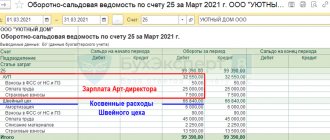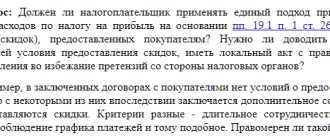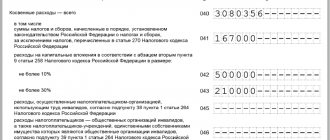What expenses are considered direct?
Art. 318 of the Tax Code classifies as direct expenses:
- Costs incurred by an enterprise in the acquisition of materials and raw materials that are used in the production of goods, as well as in the implementation of work or provision of services.
- Costs incurred by an enterprise when purchasing components for installation or semi-finished products for additional processing.
- Expenses for remuneration of employees of an enterprise involved in the production of goods, provision of services or performance of work. This category also includes expenses for compulsory pension insurance, insurance in case of temporary disability, medical insurance, social insurance against occupational diseases and accidents, and financing the funded part of the pension. The listed expenses must necessarily be accrued for the wages of workers involved in the production of goods (performance of work, provision of services). Only in this case can they be taken into account when determining income tax.
- Amounts accrued for depreciation of fixed assets, if they are used in the production of goods, performance of work or provision of services.
The list of direct expenses is open. The taxpayer has the right to independently determine his own list of direct expenses, which differs from the list from Art. 318 Tax Code of the Russian Federation. At the same time, the Ministry of Finance of the Russian Federation draws attention to the fact that the list of direct expenses determined by the taxpayer must be justified by the technological process. The judges of the Arbitration Court of the Far Eastern District share the same opinion (see resolution dated August 1, 2017 No. F03-2571/2017 in case No. A04-10568/2016. By decision of the Supreme Court of the Russian Federation dated November 24, 2017 No. 303-KG17-17016, transfer was denied case No. A04-10568/2016 to the judicial panel for economic disputes of the Supreme Court of the Russian Federation for review of this decision in cassation proceedings).
IMPORTANT! When accepting expenses to reduce the tax base for income tax, it is very important to comply with the provisions of Art. 252 of the Tax Code of the Russian Federation, according to which all expenses must be documented and economically justified.
At the same time, officials emphasize that indirect costs can include costs associated with the production of goods (works, services), only if there is no real possibility of classifying these costs as direct costs (letter of the Ministry of Finance of the Russian Federation dated March 13, 2017 No. 03-03-06/1 /13785). This point of view is shared by the arbitrators (see the decisions of the Arbitration Court of the Western Siberian District dated 08/21/2017 No. F04-3174/2017 in case No. A27-19836/2016, the Arbitration Court of the Far Eastern District dated 08/01/2017 No. F03-2571/2017 in case No. A04-10568/2016, Arbitration Court of the Moscow District dated 06/05/2017 No. F05-7067/2017 in case No. A40-136716/2016).
The list of direct expenses for tax purposes must be approved in the accounting policy for tax purposes (paragraph 10, clause 1, article 318 of the Tax Code of the Russian Federation, letters of the Ministry of Finance of Russia dated 02/21/2018 No. 03-07-07/11012, dated 03/13/2017 No. 03 -03-06/1/13785, dated 02/07/2011 No. 03-03-06/1/79 and Federal Tax Service of Russia for Moscow dated 02/02/2010 No. 16-12/ [email protected] ).
If you have access to ConsultantPlus, check whether you correctly divide costs into direct and indirect when calculating taxable profit. If you don't have access, get a free trial of online legal access.
See also the material “List of direct income tax expenses”.
General procedure for accounting for direct expenses
For direct income tax expenses, there is a special accounting procedure provided for by the Tax Code of the Russian Federation.
The essence of direct expenses is that they are taken into account only in the part attributable to goods, work, services or products after processing, sold in the current tax or reporting period (paragraph 2, paragraph 2, article 318 of the Tax Code of the Russian Federation). This statement is explained, in addition, in letters of the Ministry of Finance of Russia dated July 20, 2017 No. 03-03-06/1/46286, dated October 31, 2016 No. 03-02-07/1/63462, dated June 9, 2009 No. 03-03- 06/1/382, dated December 8, 2006 No. 03-03-04/1/821, as well as the Federal Tax Service of Russia for Moscow dated May 18, 2010 No. 16-15/ [email protected]
It is separately stated that such expenses must be written off in the period when the products are sold, even if the funds to pay for them were received in the next tax period. Confirmation of this can be found in the resolution of the Federal Antimonopoly Service of the West Siberian District dated June 15, 2011 No. A45-12953/2010.
Direct expenses in trading companies
For trading companies, the following procedure is provided for accounting for sales costs subject to write-off in the reporting period:
- the cost of goods purchased for resale is formed according to the method specified in the accounting policy (LIFO, FIFO, average cost);
- The costs of transporting the goods are taken into account (if they are not included in the price).
It is worth remembering: direct costs may include the transport costs of a trading company from the supplier’s warehouse to the buyer’s warehouse.
These costs are accepted in tax accounting as direct expenses and must be written off as a reduction in income tax immediately after the sale of goods.
All other distribution costs are classified as indirect expenses and are deducted from the income of the trading company in the reporting period when they were incurred.
Important: direct costs are credited in full only if there are no inventory balances in the warehouse. In other situations, it is necessary to document the amount of costs attributable to goods sold and their balance.
Direct costs and service sector
If the organization’s activities are related to the provision of services, then, according to paragraph. 3 p. 2 art. 318 of the Tax Code of the Russian Federation, such taxpayers are allowed to reduce income from sales by the entire amount of direct costs of the tax or reporting period (letters of the Ministry of Finance of Russia dated June 15, 2011 No. 03-03-06/1/348, dated August 31, 2009 No. 03-03-06/ 1/557). There are also court decisions on this matter, for example, the resolution of the Federal Antimonopoly Service of the West Siberian District dated August 27, 2013 No. A27-19013/2012. It also states that it is not necessary to establish such an accounting procedure in the accounting policy, since it is provided for by the Tax Code of the Russian Federation. However, it is better to reflect this in the appropriate document, which will avoid unnecessary explanations.
Works in accordance with clause 4 of Art. 38 of the Tax Code of the Russian Federation, like goods and products, differ from services in that they have a material expression and can be sold in the literal sense (for example, a constructed building, a completed project, etc.). Services do not have a material appearance (Clause 5, Article 38 of the Tax Code of the Russian Federation).
Example
Development of design documentation in accordance with Art. 758 of the Civil Code of the Russian Federation, should be classified as activities related to the performance of contract work. This means that income cannot be reduced at a time by the entire amount of direct expenses, but such expenses must be distributed among work in progress. This is what the letter of the Russian Ministry of Finance dated February 22, 2007 No. 03-03-06/1/114 aims at.
General construction costs, which include the maintenance of the construction site, including security of the village, cleaning the territory, renting equipment, temporary power supply, design and construction of temporary roads, standard design of residential buildings, development and approval of documentation for planning and land surveying of the territory, and other work, are an integral part of the construction costs. They should be considered as direct expenses of the construction company.
This conclusion was reached by the Arbitration Court of the Moscow District in its ruling dated June 5, 2017 No. F05-7067/2017 in case No. A40-136716/2016. By ruling of the Supreme Court of the Russian Federation dated September 27, 2017 No. 305-KG17-13063, the transfer of case No. A40-136716/2016 to the judicial panel for economic disputes of the Supreme Court of the Russian Federation for review of this decision in cassation proceedings was refused. But the audit applies, according to clause 2 of Art. 779 of the Civil Code of the Russian Federation, at your service. Therefore, an organization operating in this area has the right to reduce the income of the reporting period at a time by the entire amount of direct expenses. Confirmation of this thesis can be found in the letter of the Ministry of Finance of Russia dated June 15, 2011 No. 03-03-06/1/348.
If the taxpayer combines the provision of services with production or performance of work, then in full he has the right to attribute only those related to services to expenses of the reporting period (letter of the Ministry of Finance of Russia dated September 11, 2009 No. 03-03-06/4/77).
How to correctly distribute direct costs for products sold
To accurately determine the part of direct expenses that must be attributed to sold products, you should isolate the direct expenses for the month attributable to:
- For the remains of unfinished production.
- Remains of products shipped but not sold at the end of the month.
- Remaining products in warehouse.
The amounts of direct expenses that occurred in the current period on all these balances do not need to be taken into account in reducing the tax base for this period.
EXAMPLE of calculating WIP balances when producing products from ConsultantPlus: For tax purposes, the accounting policy of Legprom LLC states: “1. Direct costs are: the cost of raw materials and basic materials used in the production of products; remuneration of key production workers; insurance premiums from the wages of key production workers; depreciation of production equipment. The remaining costs are indirect. 2. To distribute direct costs to the balance of the work in progress, it is determined... view an example of the calculation in full in K+, having received trial access to the system for free.
If an organization decides to change the list of direct expenses, then it must make a change to the accounting policy from the beginning of the new tax period (paragraph 6 of Article 313, paragraph 10 of paragraph 1 of Article 318 of the Tax Code of the Russian Federation).
About the situation when the tax inspectorate may challenge the list of direct and indirect costs given in the accounting policy, read the material “Rent of industrial premises may not be recognized as an indirect expense .
As a result, from the beginning of a new reporting or tax period, certain income tax expenses will move from the category of direct to the category of indirect expenses.
However, at the end of the last tax period, direct costs attributable to unsold products and work in progress were not taken into account. The Ministry of Finance of Russia in letters dated 09.15.2010 No. 03-03-06/1/588, dated 05.20.2010 No. 03-03-06/1/336 recommends that they be taken into account in the new tax period as goods or work are sold. It will now be possible to recognize at a time only those expenses that have been incurred since the beginning of the new period.
However, in judicial practice there is also a different opinion. As an example, we can cite the situation that was considered by the FAS of the East Siberian District (resolution dated 02/03/2011 No. A78-901/2010). The essence of the matter is that in the first quarter, when calculating the income tax base, the organization took into account expenses that had previously been classified as direct in full.
Tax inspectors perceived this action as a violation, indicating in the inspection report that since the expenses were incurred in the previous tax period, they should be attributed to them. And the taxpayer had no right to write them off as indirect expenses at a time. Nevertheless, the arbitration court sided with the organization and recognized the one-time inclusion of these costs in the income tax base as legitimate. A similar position of the court is contained in the decisions of the Federal Antimonopoly Service of the Far Eastern District dated May 27, 2011 No. F03-1824/2011 and dated December 25, 2009 No. A27-671/2009.
Why divide costs into direct and indirect?
When calculating income taxes, direct and indirect expenses reduce the tax base, but at different times.
Therefore, it is necessary to divide expenses into direct and indirect in order not to make a mistake with the moment of recognizing expenses as expenses. That is, correctly determine the tax base and calculate the tax.
The tax base can be reduced by the amount of direct expenses only after the sale of products in the production costs of which they are taken into account. That is, their amount for the current month must be distributed between work in progress and products manufactured during the month (work performed, services provided).
You can write off only that part of direct expenses that falls on finished, shipped and sold products (Articles 318, 319 of the Tax Code of the Russian Federation).
Indirect expenses are written off to reduce the tax base in the month in which they were incurred, that is, without reference to sales.
Therefore, sometimes there is a temptation to expand the list of indirect expenses as much as possible and reduce the list of direct ones - in order to pay less income tax. However, it is better not to do this, but try to divide your expenses into direct and indirect so that you don’t have to pay more later.
Indirect income tax expenses: list
In accounting, indirect expenses include general production and general business expenses, i.e., expenses associated with the production of different types of products that support the activities of the organization as a whole. In this regard, when calculating the cost, they need to be distributed. The basis for the distribution of indirect costs in accounting is established by the organization independently in its accounting policies.
How to reflect indirect costs in accounting policies, see the article “Reflection of indirect costs in accounting policies - sample.”
Indirect expenses: what applies to them in tax accounting
In Art. 318 of the Tax Code, indirect expenses include all expenses except direct and non-operating ones. That is, if direct costs, the list of which must be given in the accounting policy, are excluded from production and sales costs, then indirect costs for income tax remain, the list of which is open. Indirect costs include costs for repairs, development of natural resources, R&D, property insurance, as well as other costs associated with production and sales. The composition of indirect costs for each organization will depend on the operations performed. Indirect expenses should be classified as expenses of the current tax or reporting period. This is the aim of the letter of the Ministry of Finance of Russia dated March 25, 2010 No. 03-03-06/1/182, based, in turn, on the provisions of paragraph 2 of Art. 318 Tax Code of the Russian Federation.
Example
The company has a confectionery shop, which allows it to produce and sell relevant products. If the products are not sold, then, according to the contract, they are returned and processed as raw materials. In such circumstances, direct costs of processing confectionery products should be recognized in the period in which the finished products made from processed raw materials are sold.
In tax accounting, indirect expenses are not distributed. But there is an exception to this rule: the distribution of indirect costs is made if they relate to several reporting periods. At the same time, there are indirect income tax expenses, the list of which is given below and which in tax accounting are attributed to the reduction of the tax base not at the time of occurrence, but according to a special algorithm. Such expenses, in particular, include:
- R&D expenses (Article 262 of the Tax Code of the Russian Federation);
- insurance costs (clause 6 of Article 272 of the Tax Code of the Russian Federation);
- entertainment expenses (clause 2 of article 264 of the Tax Code of the Russian Federation);
- advertising expenses (clause 4 of article 264 of the Tax Code of the Russian Federation).
ConsultantPlus has a test, by answering the questions of which you will refresh your knowledge on the topic and be able to reasonably defend the correctness of income tax calculations in the event of disputes with tax authorities. Get trial access to the K+ system and start testing for free.
Classification of NU costs (OSNO)
At NU
costs associated with production and sales are divided into:
- direct
- refer to expenses at the time of sale of products, works, services, in the cost of which they are taken into account (Article 318 of the Tax Code of the Russian Federation); - for general expenses
– in full they relate to the expenses of the current period.
The list of direct expenses is determined in the accounting policy (clause 1 of Article 318 of the Tax Code of the Russian Federation). The composition of direct costs must be economically justified and determined in accordance with the technological process and type of activity.
In 1C, the list of direct costs of the NU is specified in the UE settings:
The list must be created every year:
The distribution of direct costs for specific products, works, services is carried out according to the same method as specified in the accounting system:
Results
The taxpayer determines the list of direct expenses independently based on the specifics of his technological process. Costs related to production and sales are classified as indirect costs only if there is no real possibility of classifying them as direct costs.
Errors in the distribution of expenses between direct and indirect lead to distortion (most often understatement) of the tax base, the accrual of fines and penalties.
Therefore, any expense for the purpose of calculating income tax must not only be tested for compliance with Art. 252 of the Tax Code of the Russian Federation, but also to classify correctly. You can find more complete information on the topic in ConsultantPlus. Free trial access to the system for 2 days.
Who distributes the costs
It is not always necessary to distribute expenses into direct and indirect. The diagram will help you understand in which case this needs to be done:
As you can see, non-trading organizations in which income and expenses are determined on a cash basis do not need to divide expenses into direct and indirect. The same applies to those who use simplified or imputation instead of the general regime, as well as entrepreneurs. The latter, even if they are in the general regime, do not pay income tax.
All this follows from the provisions of Articles 272, 318 and 320 of the Tax Code of the Russian Federation.






